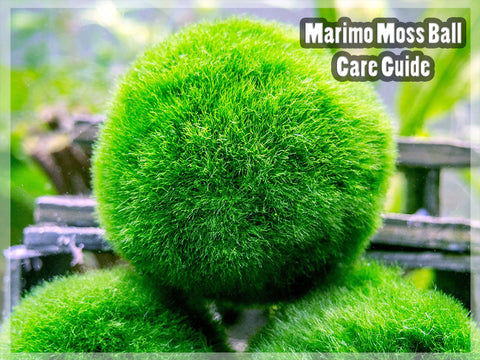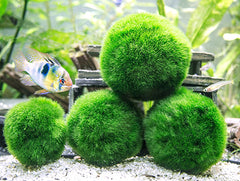Marimo Moss Ball - Care Guide
Marimo balls are one of the most popular plants in the aquarium hobby!
Widely kept as ornamental plants in jars in Japan, they also improve water quality by generating oxygen and removing nitrates.

Overview
The remarkable shape and appearance of Marimo may not seem natural, but these moss balls are formed in nature with no interference from humans whatsoever! Marimo moss balls are a highly unique and rare form of algae growth. They can only be found growing in a few lakes throughout the world, which are located in Japan, Iceland, Ireland, Scotland, and Estonia. As the algae grows in these lakes, the movement of the waves causes them to gradually form into spheres of soft, green algae with a fuzzy, velvet-like texture.
Marimo balls are regarded as good luck charms in Japan, and since they have been known to live to 200 years or longer, they are often kept as family heirlooms. They are thought to symbolize close bonds between family members or close-knit friends, and are often passed down to children and grandchildren or nieces and nephews. By the time future generations receive the Marimo, they will be larger in size and will continue to grow with each generation. Additionally, Marimo are sometimes given to young children as "pets," since their care requirements are very minimal.
Species
Aegagropila linnaei
Size
The majority of our Marimo balls range from 1.75 to 2.25 inches in diameter, which means that their estimated age is 8 to 15 years old. We occasionally have Marimo balls as large as 3 to 4 inches in diameter, and they are estimated to be over 20 years old! The largest reported size of one Marimo ball is around 12 inches in diameter.
Marimo grows VERY slowly (only about 5 millimeters per year), so it will take them an extremely long time to gain a significant amount in size. If you desire smaller Marimo, you can cut the moss balls into smaller pieces and the individual pieces will grow into separate nano Marimo balls.

Basic Care Requirements
As mentioned, Marimo balls require very little maintenance. They can be kept in tap water, though they will remain cleaner longer in filtered or reverse osmosis water. Interestingly, Marimo can live in brackish water - in fact, it is often recommended to add a little ocean salt to the water if a Marimo is developing brown spots.
The lakes in which Marimo are naturally found are cold in temperature, so Marimo do best in cooler water (we recommend a water temperature no higher than 76° F). Brown spots may form on your Marimo if their water is too warm. If you find your water gets too warm during the hotter months, you can give your Marimo a “vacation” by putting it in a water-filled container in your refrigerator for up to 24 hours at a time.
Marimo balls are excellent for aquariums, but they can also be kept successfully in glass bowls, bottles, vases, and a variety of other containers. Marimo do not need air, so they are able to survive in sealed containers.
You may find that your Marimo takes one to two days to sink to the bottom of your tank or container. Floating Marimo likely means that there are air bubbles trapped inside the balls. You can gently squeeze the Marimo while holding it under water to let the air bubbles out.
Lighting
Marimo naturally form at the bottom of a lake, so they do not require special or high intensity lighting. Normal household lighting or indirect sunlight from windows often provide enough light for Marimo to photosynthesize. They tend to do just fine with most aquarium lights and lamps. Lighting that is too intense (such as direct sunlight or high-intensity LED lights) may cause brown spots to appear on your Marimo.
If your Marimo is stationary for long periods of time, you may need to flip or rotate the ball to ensure that all sides of it receive enough light.
Water Changes
Water changes are important for preventing dirt and waste from building up on your Marimo. The percentage and frequency of water changes will depend on the aquarium or container in which you keep your Marimo. If you are keeping the Marimo by itself, with no other plants or animals in the container, we recommend a 50% water change every two weeks or so. If you are keeping the Marimo in a tank with animals and other plants, water change requirements will depend on your situation and will likely need to be done more frequently.
Cleaning Marimo
If you are not keeping your Marimo with algae-eating animals (such as dwarf shrimp and several kinds of fish), you will likely need to clean your moss balls from time to time. This can be accomplished by taking your Marimo out of the water and rinsing it, followed by placing it in a container of clean water and gently squeezing the ball a few times.
While you are doing this, it is also a good idea to carefully roll the ball in your hands for a few moments. Since the Marimo is no longer living in a lake with the motion of waves, you may find that your Marimo becomes misshapen over time. Rolling the ball gently will help it regain its round shape.
Tank Mates
Most animals can live in the same tank with Marimo. However, a few types of fish and invertebrates may eat or damage the Marimo balls, including Goldfish, some types of Plecostomus (Plecos), and large-sized crayfish.

What to Expect from Us
Our Marimo balls generally range from 1.75 to 2.25 inches in diameter, though we often send larger ones. This means that our Marimo balls are 7 to 10 times as large as nano Marimo - the type of Marimo balls most commonly sold online. We may sometimes send nano-sized Marimo balls as extras with an order.
All Aquatic Arts brand plants and animals come with a 100% live arrival guarantee, plus free email support directly from the owners!

